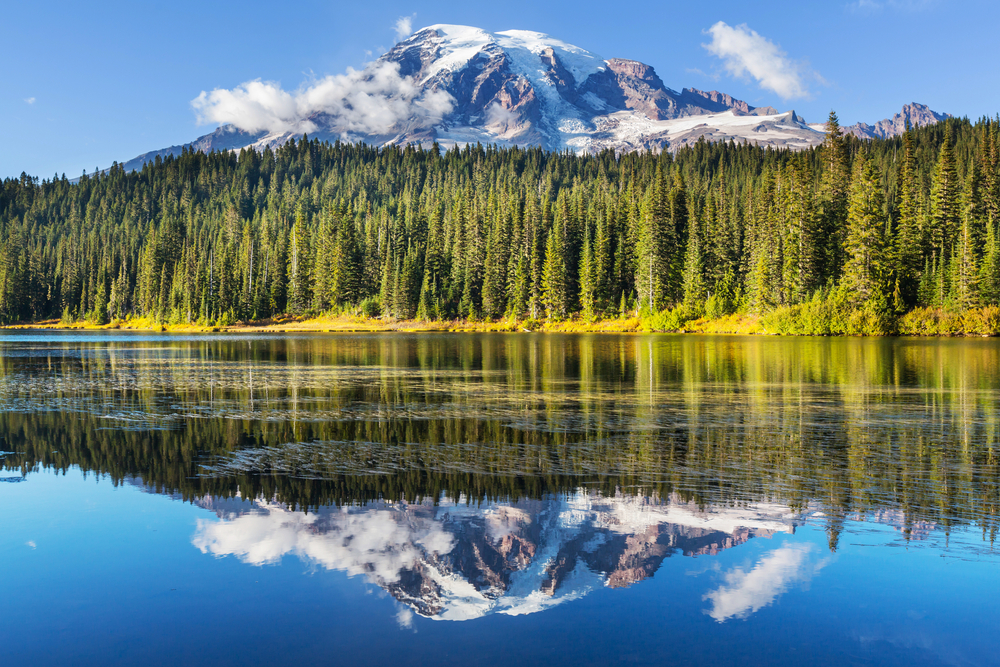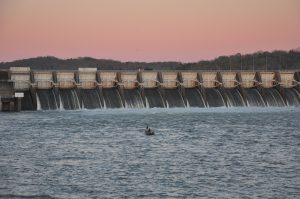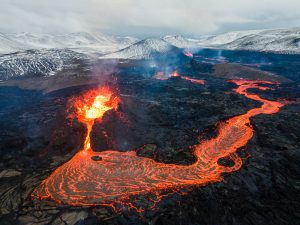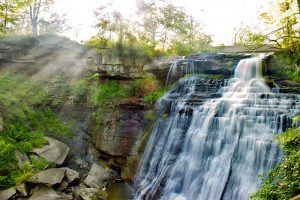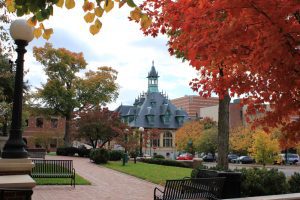Established back in 1899, Mount Rainier was one of the very first areas to be labeled as a national park and it has been stealing the hearts of its visitors ever since.
Although Mount Rainier itself isn’t one of the tallest peaks in the country, it is easily one of the most impressive thanks to its abundance of glaciers.
In fact, this grand mountain has more glaciers than any other mountain in the continental United States, clocking in at a whopping twenty-five glaciers along its edges.
Everywhere you go within this national park you will get to enjoy the beauty of this extraordinary mountain but there are many highlights to consider as well.
For starters, the park is made up of endless alpine meadows overflowing with vibrant wildflowers, and nearly three hundred different animal species call the area home.
This means you’ll get to enjoy the beauty of its alpine environment and watch for wildlife, all while taking in a view of a mountain that never gets old.
You can spend weeks if not years exploring the many wonders that lie within this 236,381-acre park, so check out this list of the top 14 things to do in Mount Rainier National Park to make the most of your next trip.
Table of Contents
1. Myrtle Falls
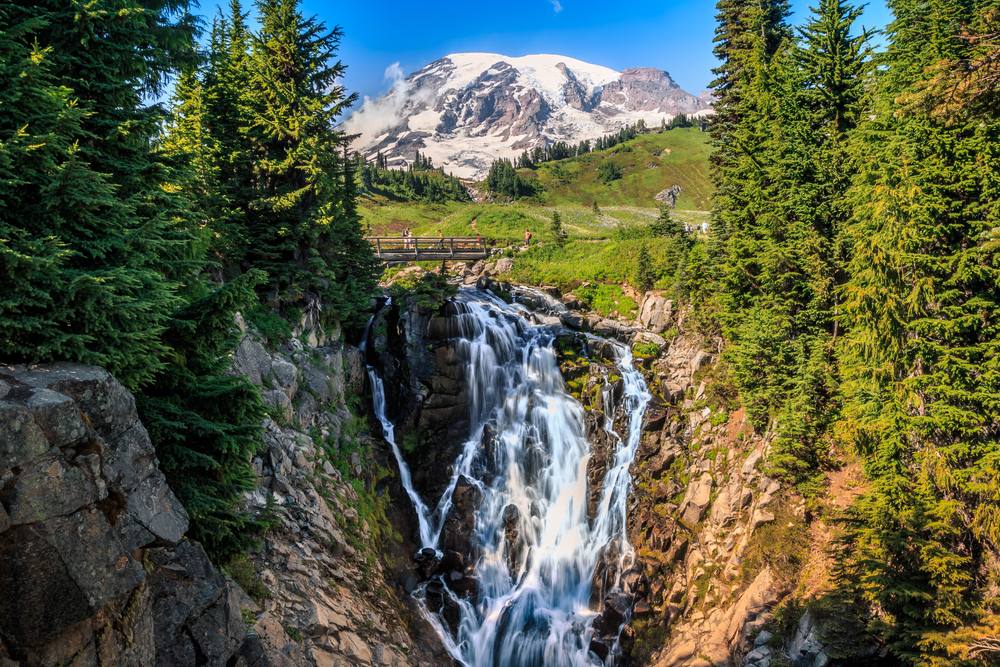
Known for being one of the most popular destinations for aspiring photographers, Myrtle Falls is a breathtaking sight that always has the iconic mountain in view.
You’ll find this gem in the Paradise section of the national park just a short drive from one of the best places to rest your head, Paradise Inn.
The trail to reach these falls is relatively short, clocking in at a little under one-mile round trip and gaining very little elevation in the process.
This is one of the hikes in Mount Rainier National Park that is suitable for all experience levels, and a paved path makes trail navigation as easy as can be.
Along your trek to this waterfall, you will notice a variety of spur trails that lets curious explorers extend their hiking time and venture to some of the more quiet parts of the park.
Before you know it, you will cross over a picturesque footbridge that leads you over the Edith Creek Basin and guides you to the Myrtle Falls viewing area.
Once you arrive at the falls, you will probably be accompanied by a series of photographers with their tripods setting up for the best shot.
It is not hard to figure out why this is such a hot spot for content creators when you are standing above this awe-inspiring 72-foot waterfall.
This towering waterfall cascades down an intense gorge, and you get to admire its powerful beauty by standing atop a footbridge that overlooks the drop.
When you are not admiring the wonders of this gushing waterfall, you can look in the other direction and see the breathtaking Mount Rainier standing tall out in the distance.
Just keep in mind that this trail is not accessible during the winter months, as heavy snowfall results in road closures and halts in trail maintenance.
2. Paradise Inn
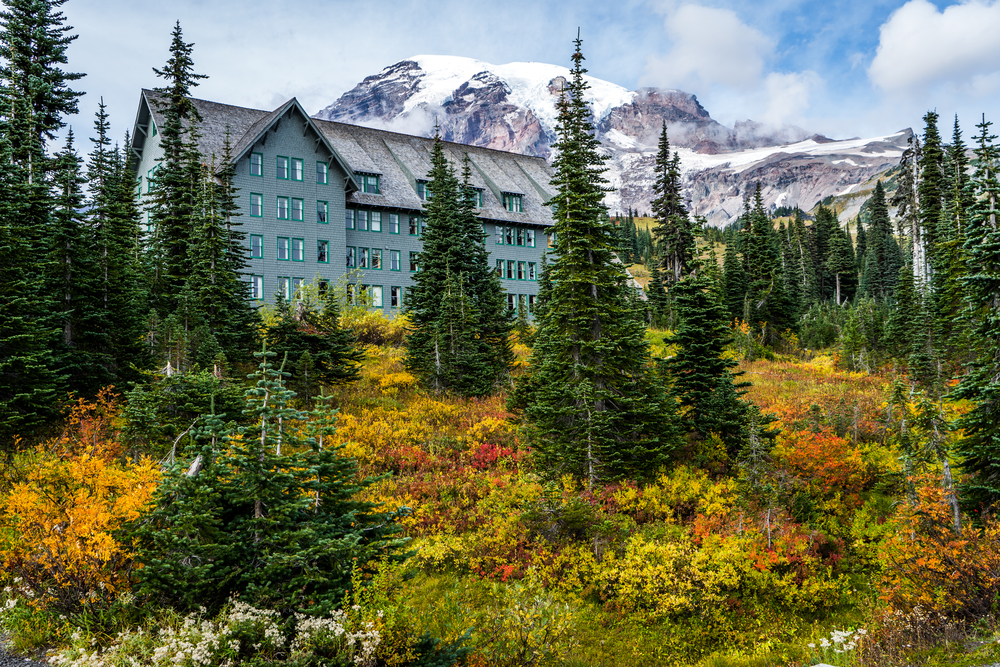
Paradise Inn is one of the most popular lodging options when visiting Mount Rainier National Park, but this iconic hotel has more to offer than just a comfortable place to sleep.
Having been named one of the few “Great Lodges of the West,” it is hard not to see the appeal since the beauty of Mount Rainier is almost always in view.
The hotel was established back in 1916 and has been restored throughout the years to ensure that this historic inn always holds true to its name.
There are over one hundred rooms to choose from, and although modifications have been made over time for the enjoyment of the general public, the inn still follows a simplistic style with no televisions and internet in any of the rooms.
This helps guests to fully embrace the beautiful world that is around them and spend more time out on the hiking trails rather than in their rooms.
And speaking of hiking trails, since the inn is located in such an ideal spot within the national park, there is no shortage of places to explore in the general area.
Plus, even if you aren’t spending the night at Paradise Inn, you can still stop in for a visit to enjoy some of its many amenities.
Some of the most popular things to do here include listening to the piano with a cocktail in hand, sipping coffee while listening to a ranger talk at the Tatoosh Cafe, and enjoying a hearty meal in the Paradise Inn Dining Room next to a roaring fireplace.
3. Longmire

Originally the park headquarters back when Mount Rainier was first established as a national park in 1916, the Longmire Visitors Center is a must-stop destination for anyone exploring the area.
Even before Longmire was declared the park headquarters, this building served many purposes, like being a mineral hot springs resort, a hotel, and originally the homestead for James Longmire himself.
This just further demonstrates the importance of this historic building and more information about its rich history can be found within its doors.
Although it is no longer the park headquarters, Longmire is considered one of the best visitor centers in the park with a variety of resources to inform travelers about Mount Rainier and its surroundings.
Within the visitor center, you will find an extensive museum that uses displays and exhibits to shine a light on how the national park has evolved over the last hundred years.
This is also a great place to find any national park-related books and is one of the few destinations where hikers can obtain backcountry permits.
Just keep in mind that this visitor center can get extremely busy given its picturesque location and historic fame, so try to stop in early in the morning to beat the crowds.
On the bright side, this visitor center is open year-round, so you never have to worry about the place shutting down during the quiet months when snowfall is in abundance.
4. Tolmie Peak Fire Lookout
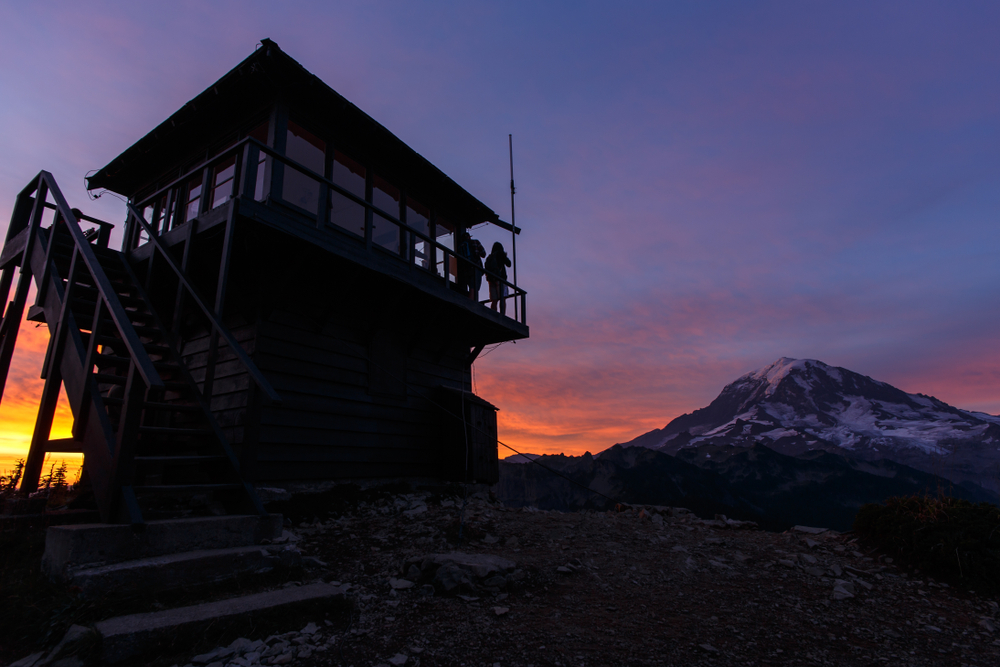
Known for being one of the most popular hikes in Mount Rainier Park, the Tolmie Peak Fire Lookout is an exciting way to take in the views of the park’s iconic mountain.
Plus, the Tolmie Peak Fire Lookout is one of the last four fire lookout towers in the park, so a visit here is also a historic one.
Not to mention the fact that the trail leading up to this significant fire lookout is jam-packed with breathtaking views aside from the gorgeous Mount Rainier itself.
The trail is almost six miles long with a steady elevation gain of more than fifteen hundred feet, so it will definitely get your heart pumping, but the views are worth every step.
Because of its length, the trail is rated as moderate, but it is manageable by most experience levels thanks to the many beautiful places to stop and take a break.
Most people who plan to visit Mount Rainier have this planned as a day hike, so expect to see many large groups and families along the trail during your adventure.
As you make your way nearly three miles up to the fire tower, you will be amazed by some of the trail’s many highlights like alpine lakes and lush meadows overflowing with vibrant wildflowers.
You will even pass the largest alpine lake in the national park, Eunice Lake, during your hike and many people opt to stop here for a picnic along one of its sandy coves.
From here, it is a short but steep trek up to the two-story fire tower where you will be rewarded for your efforts with panoramic views of the national park and the famous mountain itself.
This is one of the best views of Mount Rainier in the entire park and it is an extremely popular destination for both sunrise and sunset.
But the view of Mount Rainier is just one of the spectacular sights you’ll see when standing atop this fire tower. Make sure to look all around you as you can admire Eunice Lake, Mowich Lake, Mount St. Helens, Mother Mountain, and so much more from this great spot.
5. Reflection Lakes

Another one of the national park’s most popular attractions is the hike to Reflection Lakes, where wildflowers bloom in abundance and the views of Mount Rainier are unmatched.
The lake gets its name for the magical way that Mount Rainier and the bright blue sky that surrounds it perfectly reflects on its crystal-clear waters.
This, in combination with the overflowing number of colorful wildflowers, makes Reflection Lakes a photographer’s dream, and you will spot many people here at any time of day trying to get the postcard-worthy photo.
There are actually quite a few different trails that eventually lead to Reflection Lakes, but the most popular route is the Lakes Trail which is just a little over three miles round trip.
This trail starts on one side of the lake, climbs up to walk along a nearby ridgeline, and then descends back down to the other side of the lake so you get to take in its beauty from a variety of different angles.
Another popular trail that lets you explore Reflection Lakes is the Pinnacle Peak Trail, and although it is shorter than the Lakes Trail, it is definitely more difficult.
The Pinnacle Peak Trail climbs more than one thousand feet of elevation in a little over a mile and takes hikers across an abundance of switchbacks as it makes its way between two of the national park’s iconic peaks.
Keep in mind that this is a very fragile lake, so fishing and boating are not permitted at any time and guests are asked to stay on the marked trail in order to help maintain the environment.
Another important thing to note is that Reflection Lakes can only be accessed between the months of June and September, so this only adds to the heavy traffic during the peak season.
6. Naches Peak Loop
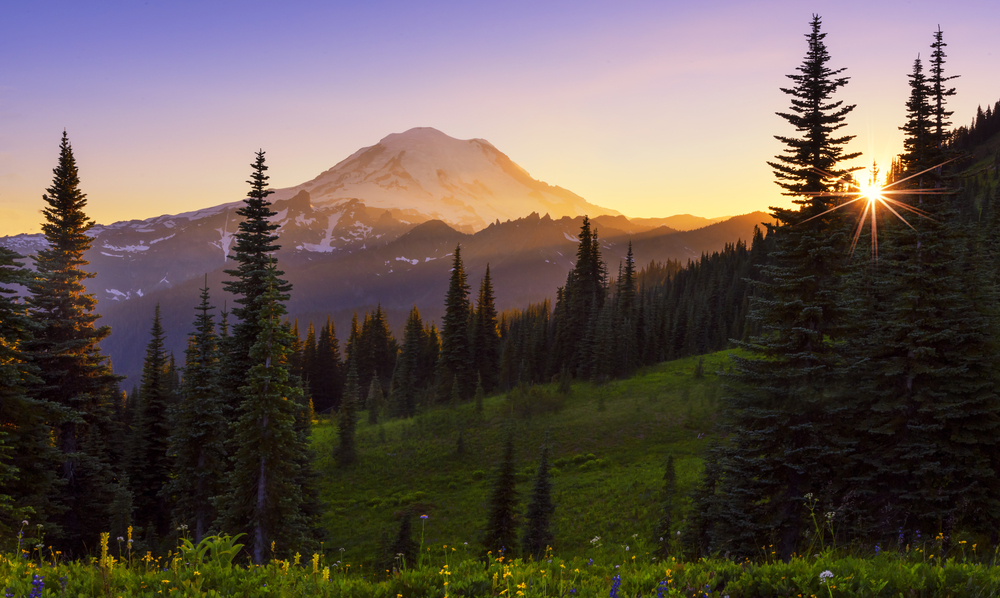
Famous for its varying landscapes, Naches Peak Loop is a great way to see all of the beauty that Mount Rainier National Park has to offer.
The trail itself is a little over three miles and, with its six hundred feet of elevation gain, the hike is considered a moderate trek.
Although you can start this loop in either direction, the national park service recommends that you travel in a clockwise motion to get the very best view of Mount Rainier.
You’ll start your journey with views of Tipsoo Lake before making your way up the hillside where you will be surrounded by the beauty of open meadows.
During the summer months, these meadows are overflowing with colorful wildflowers like blue lupine and magenta paintbrush that make for a truly spectacular sight.
You will get to walk a portion of the iconic Pacific Crest Trail as you make your way over to a breathtaking viewpoint of Dewey Lake where many people stop for a scenic lunch.
The views only get better as you make your way along Naches Peak and through a picturesque alpine meadow that is complemented by the towering Mount Rainier.
This hike starts off in a national forest and works its way into the national park, so you may see dogs on the trail at the beginning but just keep in mind that your canine friends cannot continue on into the national park.
7. Narada Falls
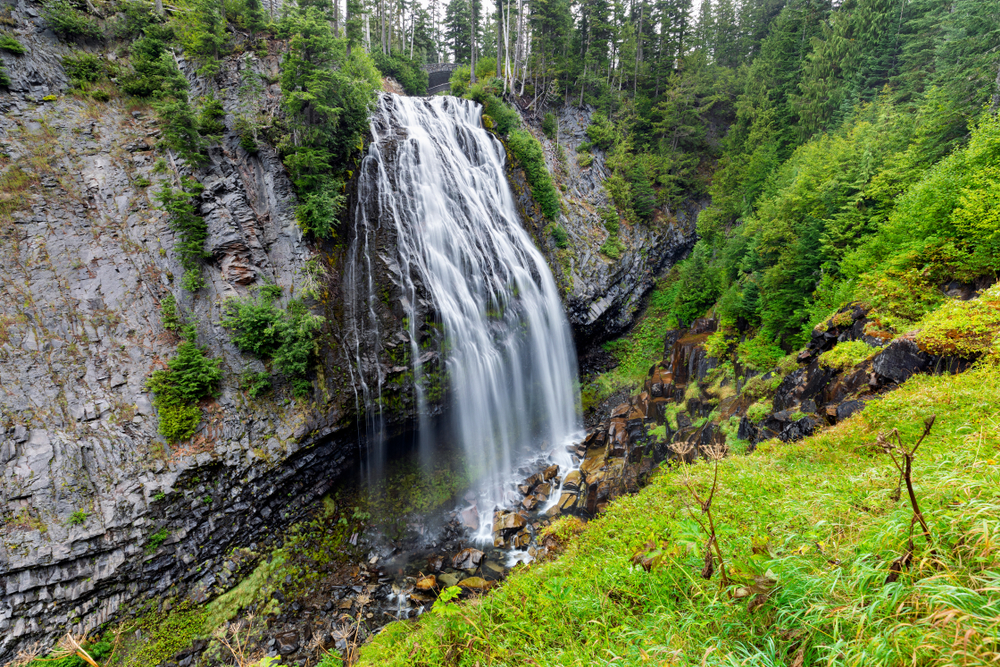
Often hiked in combination with Reflection Lakes, Narada Falls is one of the most beautiful waterfalls in the park and its easy access also makes it one of the most visited.
Just a short drive from the Longmire, you can reach the base of Narada Falls by parking in the viewpoint parking lot located right off the main road and taking a short hike.
Right as you get out of your vehicle, you will be drawn to the stone bridge that overlooks the falls, but taking the 0.2-mile hike down to its base will score you the best views.
Just keep in mind that this short trail is a relatively steep downward slope, so you will have a bit of a workout on your way back up, and is usually very wet so good footwear is important.
Once at the bottom, you will be in awe of the falls’ impressive fifty-foot width and its towering stature dropping down nearly one hundred seventy feet.
Part of what makes this waterfall so special is its variation with the top section of the falls cascading down before coming together as a solid plunge in the lower section.
After you have worked up a sweat on the incline back up to the parking lot, stop in at the rest area where you can catch your breath on one of its comfortable couches.
As mentioned earlier, there are also many other trails that make their way to the base of Narada Falls, so you will have options for further exploration if you are up for it.
8. The Grove of the Patriarchs Trail
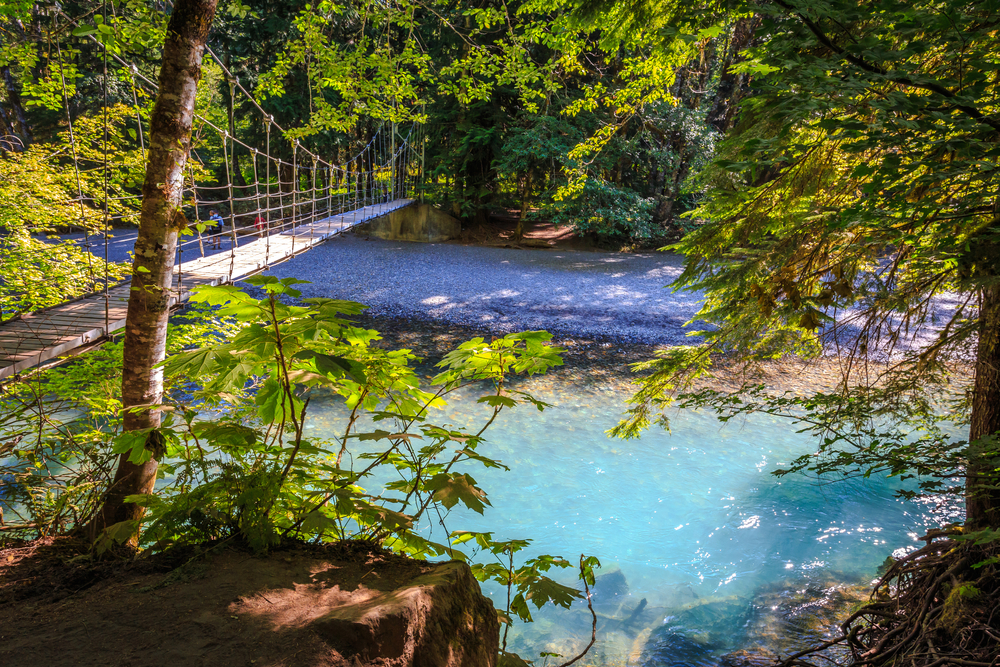
Perfect for travelers who are just getting into hiking or experienced hikers looking to stretch their legs, The Grove of the Patriarchs Trail is considered one of the easiest hikes in the park and it is also one of the most beautiful.
Tucked away along the eastern edge of Mount Rainier National Park, a scenic drive will take you up 2,200 feet in elevation where you will start your hike.
The trail is no more than one and a half miles roundtrip with zero elevation gain making it an enjoyable trip for all experience levels.
You will feel like you have entered a page in a fairytale as you make your way between giant, old trees leading you up to a suspension bridge that will take you to a surreal, little island.
The bridge takes you across a scenic portion of the Ohanapecosh River and it is impossible not to stare in awe of its crystal-clear, turquoise waters.
Once you arrive on the island, you will be surrounded by ancient trees dating back more than one thousand years and standing taller (and wider) than any others within the park.
Stop to admire their grand size as you read about their rich history and dynamics on various interpretive signs throughout the loop.
This is a trail that can be done in less than an hour, but many people spend a lot longer here marveling at the beauty of the untouched nature that surrounds them.
Keep in mind that because this trail is so accessible, it is extremely busy during the summer months and the parking lot is usually full by mid-morning.
9. Spray Park
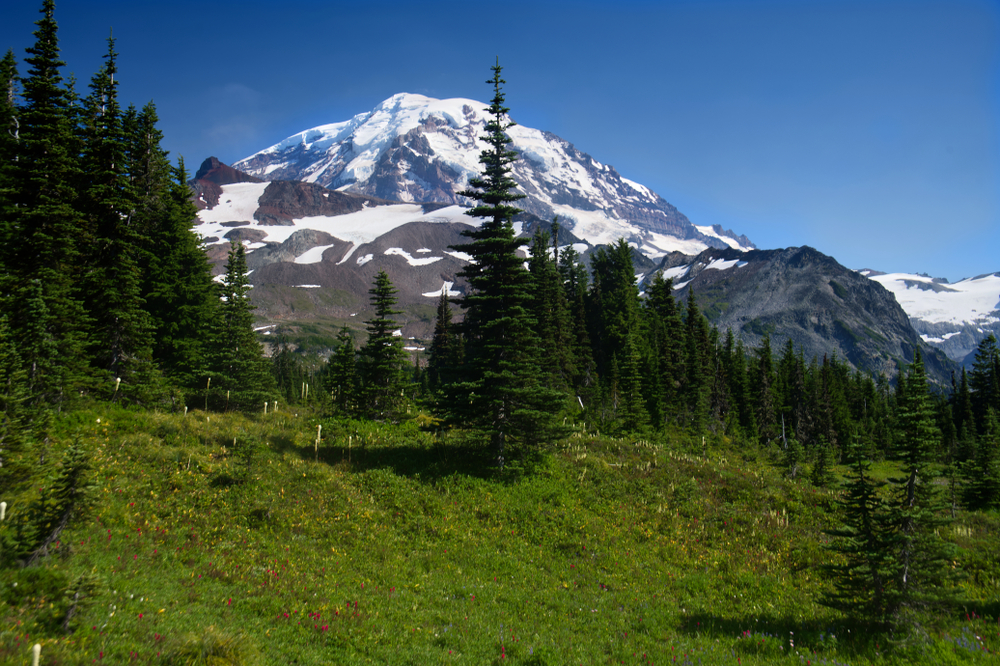
If you are hoping to beat some of the crowds that flood Mount Rainier National Park each year, consider taking the Spray Park trail for a longer but equally scenic route for views of Mount Rainier.
Part of the reason that this picturesque trail sees less traffic is that it is quite difficult, so make sure you are physically and mentally prepared for a strenuous day before starting your hike.
This means you should be prepared with good hiking shoes, snacks to keep you energized, and plenty of water to ensure that you stay hydrated throughout the entire adventure.
The hike starts at the Mowich Campground which already sits at an elevation of 3,600 feet and the trek up gains over two thousand feet which brings you to a whopping 5,800 feet of elevation once you reach the top.
As you climb, you will have plenty of wonderful sights to distract you from the burning in your legs like moss-covered trees, flowing waterfalls, alpine meadows, and of course a view of the iconic Mount Rainier itself.
The further you go on this hike, the better the views become with more star attractions eventually showing themselves like Observation Rock and Echo Rock.
10. Eagle Peak

A perfect representation of all Mount Rainier National Park has to offer, Eagle Peak is one of the very best places to explore if you are able to handle the strenuous hike that comes with it.
This hike has a little bit of everything from its picturesque alpine meadows boasting wildflowers to the unparalleled views of the famous Mount Rainier itself.
Not to mention, the peaceful walk through a canopy of overgrown, ancient trees and views of other peaks like Mount Hood, St. Helens, and Mounts Adams along the way.
To reach the trailhead, you will have to drive over the historic Nisqually Suspension Bridge which was originally built back in the 1920s and then officially restored in the late 1950s.
The trail is just over seven miles round trip with a steady elevation gain of nearly three thousand feet using a series of switchbacks that are sure to pack a punch.
Take a moment to breathe at the picturesque creek crossing and make sure to refill on water if needed because there are no other water sources along the trail.
Soon you will make your way above the tree line and into a breathtaking alpine meadow gushing with wildflowers and wide, sweeping views.
Your eyes will definitely be glued to the beauty of Mount Rainier up ahead, but remember to look back every once and a while to take in the stunning views of some of Washington’s other famous peaks out in the distance.
Have a seat at the top of the trail where a bench sits in the perfect position to admire the mesmerizing view of Mount Rainier.
Just remember that although this trail is open year-round, its exposed ridgeline makes it a common location for avalanches, so only experienced hikers should attempt this hike during the winter months.
11. Snow and Bench Lakes
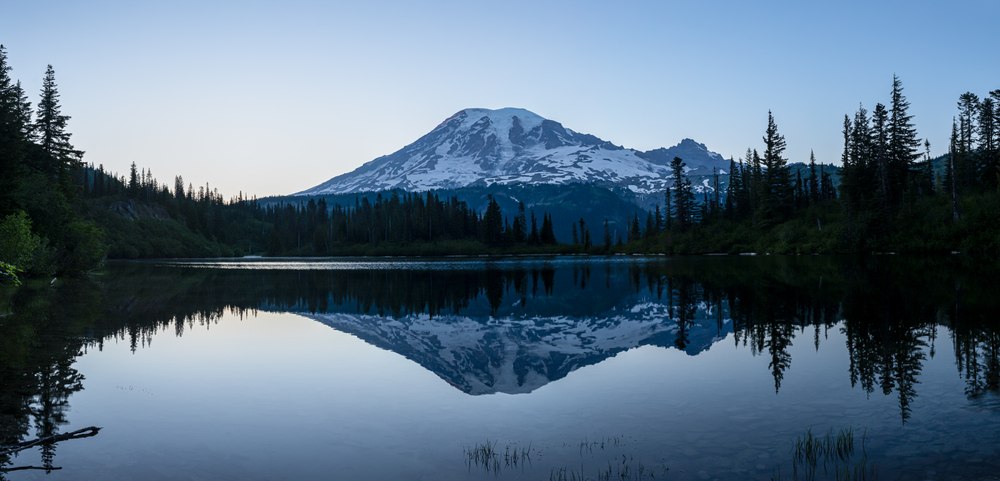
Another great trail to check out if you are hoping to beat the crowds at Mount Rainier National Park is Snow and Bench Lakes but the light foot traffic isn’t the only thing you get to enjoy on this hike.
For starters, the trail offers a good “bang for your buck” as it is only two and a half miles in length round trip and provides a variety of different views to enjoy.
The start of the trail is well shaded, providing travelers with a moment of relief on hot summer days, and quickly ascends up to the first lake.
Eroded steps lead you up and down for about half a mile before you reach Snow Lake where you can take a moment to rest while admiring this alpine beauty.
Then continue on to Bench Lake, but make sure to keep your head up because you will catch glimpses of Mount Rainier along your journey.
Once you make it to Bench Lake you will be rewarded with an even more spectacular view as Mount Rainier stands tall behind it and creates that picture-perfect moment.
There are two campsites available just steps away from this trailhead at Snow Lake Camp, but you’ll have to apply for a permit in order to spend a night here.
12. Wonderland Trail
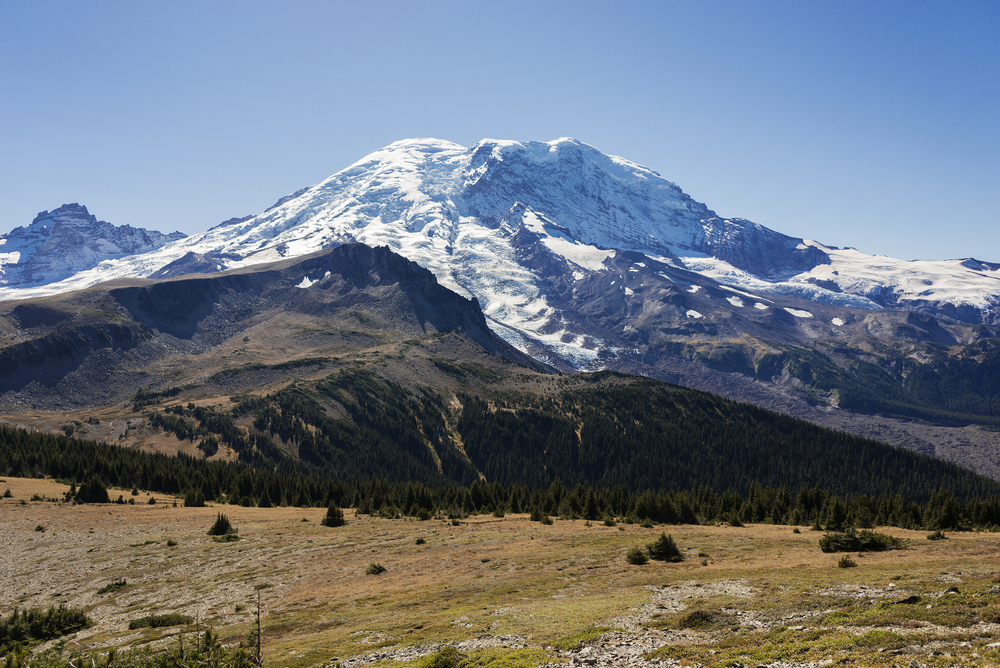
Known as a bucket list item for experienced hikers, the Wonderland Trail is one of the national park’s most iconic but is also one of the most difficult.
The trail itself stretches out more than ninety miles, so anyone serious about hiking it from start to finish has a strenuous backpacking trip on their hands.
But it is hard not to see the appeal as the trail literally encircles the beautiful Mount Rainier and provides hikers with every viewpoint imaginable.
Plus, you’ll get to experience all of the national park’s many breathtaking environments like alpine meadows and old-growth forests.
This extraordinary challenge is attempted by thousands of hikers each year but it still manages to provide people with time alone to enjoy the views all to themselves.
Keep in mind that this trail has many sections located high above the ridgeline where you can be exposed to extreme weather at any time of year.
This is why it is so important for anyone hiking this trail to be fully prepared and have a clear understanding of the safety precautions.
On average, it takes people about two weeks to complete the trail in its entirety and backcountry permits are required before setting out on this adventure.
13. Sunrise Point

Only open a few months out of the year because of the heavy snowfall at its high elevation, Sunrise Point is an absolute must-see if you get your timing right.
The viewpoint was once home to a resort that housed more than two hundred cabins back in the early 1900s, but extreme weather conditions slowly but surely closed down the business.
Today, the area is a wide-sweeping alpine meadow that overlooks a variety of breathtaking peaks and is a great starting point for a wide range of hiking trails.
It is also here where you will find the Sunrise Visitor Center which has been labeled as the highest visitor center in the park because of its 6,400-foot elevation.
As the name suggests, this area is one of the most breathtaking places to catch the sunrise, so make sure to get here bright and early for a chance to watch the sun make its way up above the mountains.
From here you will get to admire the grand Mount Rainier, but you will also get to check out some other cool formations like the Goat Rocks stratovolcano and the second tallest peak in the state (Mount Adams).
14. Mount Fremont Lookout Trail
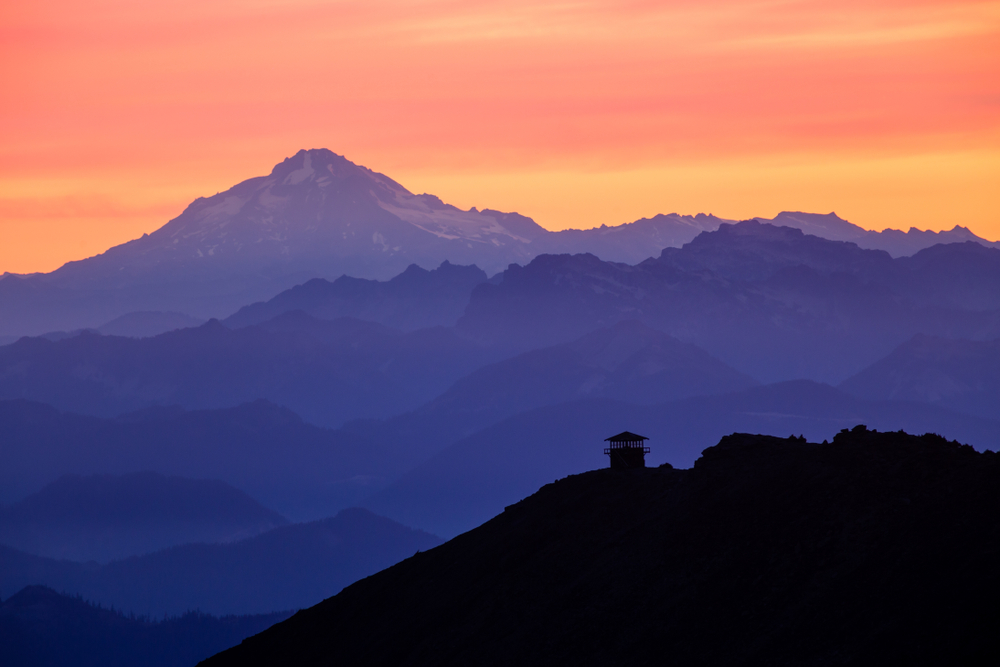
Another one of the four historic fire towers that remain in Mount Rainier National Park can be found on Mount Fremont Lookout Trail, a gem of a hiking trail that provides you with a view you won’t find anywhere else.
Part of what makes this particular fire tower so special is that it is the one that sits at the highest elevation, but, luckily, the trailhead starts at 6,400 feet so the elevation gain is less than one thousand feet.
Nonetheless, once you make it to the top of Mount Fremont, you will be rewarded with wide sweeping views of various mountain ranges and a chance to see a herd of mountain goats on the rocky terrain.
The hike is a little over five miles round trip but feel free to take as much time as you want sitting atop the fire tower to take in the breathtaking views that surround you.
Everywhere you look will leave you in complete and utter awe as your shift gazes from Mount Baker to Grand Park to the Puget Trough and everything in between.
But nothing can compare to the sight of Mount Rainier on the south end of the lookout with such a close view that it looks almost like you can reach your hand out and touch it.
Many people decide to have lunch on the fire tower’s catwalk but make sure to keep your eyes out for hungry ground squirrels that have no problem trying to steal your food.

